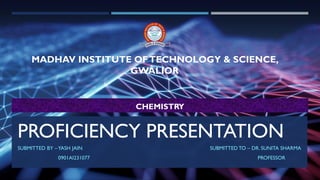
engineering chemistry power point presentation
- 1. PROFICIENCY PRESENTATION SUBMITTED BY –YASH JAIN SUBMITTED TO – DR. SUNITA SHARMA 0901AI231077 PROFESSOR MADHAV INSTITUTE OFTECHNOLOGY & SCIENCE, GWALIOR CHEMISTRY
- 2. CO1 SELECT THE BEST TECHNIQUE FOR INDUSTRIAL AND DOMESTIC WATERTREATMENT Water treatment is crucial for ensuring safe and clean water in both industrial and domestic settings. The selection of the most appropriate water treatment technique is paramount for meeting water quality standards and ensuring public health.
- 3. CO1 SELECT THE BEST TECHNIQUE FOR INDUSTRIAL AND DOMESSTIC WATERTREATMENT • Industrial Techniques: • Filtration (Reverse Osmosis, Ion Exchange): Removal of dissolved solids and ions through membranes or exchange resins. • Electrodeionization: Continuous removal of ions from water using ion-exchange membranes and an applied electrical potential. • Domestic Techniques: • Chlorination: Disinfection by adding chlorine compounds. • UV Disinfection: Use of ultraviolet light to destroy pathogens. • Filtration (Activated Carbon, Membrane): Removal of impurities through adsorption or physical barriers.
- 4. CO1 SELECT THE BEST TECHNIQUE FOR INDUSTRIAL AND DOMWSTIC WATERTREATMENT • Water Quality Requirements: Consider parameters such as pH, hardness, and microbiological contaminants. • Cost-Effectiveness: Evaluate initial capital costs, operational expenses, and maintenance requirements. • Space and Maintenance Needs: Assess available space for installation and the level of expertise required for maintenance. • Environmental Concerns: Consider the environmental impact of the treatment process, including energy consumption and waste generation.
- 5. CO2 : DISTINGUISH THE CHEMISTRY OF VARIOUS FUELS AND THEIR COMBUSTION Fuel Types and their Chemical Composition Fuels come in many forms, each with a unique chemical makeup. Gasoline, for example, is a complex mixture of hydrocarbons, while natural gas is primarily composed of methane. Understanding the chemistry of these fuels is crucial for optimizing their combustion and minimizing environmental impact.
- 6. CO2 : DISTINGUISH THE CHEMISTRY OF VARIOUS FUELS AND THEIR COMBUSTION The Chemistry of Combustion Reactions Ignition : Combustion begins with the ignition of the fuel, which starts a rapid, exothermic reaction. Oxidation : The fuel molecules react with oxygen, breaking down and releasing energy in the form of heat and light. Byproducts : The combustion process also produces various byproducts, such as carbon dioxide, water vapor, and potentially harmful emissions.
- 7. CO4 : DESCRIBE POLYMERIZATION MECHANISM AND TYPES OF POLYMERS,THEIR PROPERTIES AND APPLICATION What Is Polymerization? Polymerization is a process through which a large number of monomer molecules react together to form a polymer. The macromolecules produced from a polymerization may have a linear or a branched structure. They can also assume the shape of a complex, three-dimensional network. There exist several categories of polymerization reactions; the most important ones are step-growth polymerization, chain-growth polymerization (both fall under the category of addition polymerization), and condensation polymerization. A polymer is a substance that is made up of very large molecules that are, in turn, made up of many repeating units called monomers. Polymerization is the process through which these monomers come together to form the macromolecules that constitute polymers.
- 8. CO4 : DESCRIBE POLYMERIZATION MECHANISM AND TYPES OF POLYMERS,THEIR PROPERTIES AND APPLICATION Mechanism of Polymerization : Generally, polymerization consists of three steps which include initiation, propagation, and termination. As for the reaction mechanism, the process of polymerization mainly involves two different methods, the step-growth mechanism and the chain- growth mechanism. Types of Polymers • Natural Polymers : They occur naturally and are found in plants and animals. For example, proteins, starch, cellulose and rubber. To add up, we also have biodegradable polymers called biopolymers. • Semi-synthetic Polymers : They are derived from naturally occurring polymers and undergo further chemical modification. For example, cellulose nitrate and cellulose acetate. • Synthetic Polymers: These are human-made polymers. Plastic is the most common and widely used synthetic polymer. It is used in industries and various dairy products. For example, nylon-6, 6, polyether, etc.
- 9. CO4 : DESCRIBE POLYMERIZATION MECHANISM AND TYPES OF POLYMERS,THEIR PROPERTIES AND APPLICATION Properties and Application of Polymers Physical Properties • As chain length and cross-linking increase, the tensile strength of the polymer increases. • Polymers do not melt, and they change state from crystalline to semi-crystalline. Chemical Properties • Dipole-dipole bonding side chains enable the polymer for high flexibility. • Polymers with Van der Waals forces linking chains are known to be weak but give the polymer a low melting point. Optical Properties • Due to their ability to change their refractive index with temperature, as in the case of PMMA and HEMA: MMA, they are used in lasers for applications in spectroscopy and analytical applications. The rapid increase in demand for the manufactured products introduce the new materials. These new materials are polymers, and their impact on the present way of life is almost incalculable. Product made from polymers are all around us: clothing made from synthetic fibers, polyethylene cups, fiberglass, nylon bearings, plastic bags, polymer-based paints, epoxy glue, polyurethane foam cushion, silicone heart valves, and Teflon-coated cookware. The list is almost endless.
- 10. THANKYOU